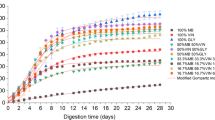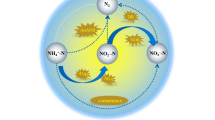Abstract
Oil sludge degradation studies were conducted using individual bacterial strains and their formulated consortium “Oil busters” isolated from tank bottom oil sludge. Four potential strains were selected on the basis of biosurfactant production, presence of catabolic gene and aromatic fraction utilization which further characterized using hydrocarbon compounds as the carbon source. Surface tension, emulsification index and bacterial adhesion towards hydrocarbons (BATH) test were also performed. All four strains were selected for consortium preparation and degradation studies were conducted for 20 days in Minimal media inoculated with individual strains and consortium. The strains used after identification on the basis of 16 s rDNA sequencing were named as AAJ1; AAJ2, AAJ3 and AAJ4. At the end of the study, consortium showed effective degradation of oil and its components as compared to individual strains. The consortium degraded a maximum of 78 % of oil, followed by strains AAJ1 70 %, AAJ3 58 %, AAJ2 57 % and AAJ4 56 %. In the total petroleum hydrocarbons (TPH), highest degradation was found by consortium (75 %) followed by AAJ2 (57 %), AAJ3 (56 %), AAJ1 (55 %) and AAJ4 (54 %) respectively. The strains AAJ1 and AAJ2 were identified as Bacillus sp. and AAJ3 and AAJ4 as Pseudomonas sp., respectively. A total of nine polycyclic aromatic hydrocarbons (PAHs) were detected in aromatic fraction of oil sludge and gas chromatography-mass spectroscopy (GC–MS) profile confirmed the complete removal of these compounds in the presence of consortium. The findings come up with a potential bacterial formulation, i.e. “Oil buster” for planning bioremediation strategy for oil sludge/PAH contaminated sites.



Similar content being viewed by others
References
Hu G, Li J, Guangming Z (2013) Recent development in the treatment of oily sludge from petroleum industry: a review. J. Haz. Matter. 261:470–490
Elisa RN, José Perales-Vargas-Machuca A (2012) Microbial degradation of PAHs: organisms and environmental compartments. Microbial degradation of xenobiotics. Environ Sci Eng 12:263–290
Krishnamurthi K, Devi SS, Chakrabarti T (2007) The genotoxicity of priority polycyclic aromatic hydrocarbons (PAHs) containing sludge samples. Toxicol Mech Meth 17:1–12
Ghazali FM, Zaliha RN, Rahman A, Salleh AB, Basri M (2004) Biodegradation of hydrocarbons in soil by microbial consortium. Int Biodete Biodegrad 54:61–67
Moliterni E, Gómez R, Rodríguez L, Fernández FJ, Villaseñor J (2012) Biosurfactants production during diesel biodegranation by mixed microbial consortia selected from polluted spolls. Int J Environ Res 6(3):751–760
Mohamed ME, Al-Dousary M, Hamzah RY, Fuchs G (2006) Isolation and characterization of indigenous thermophilic bacteria active in natural attenuation of bio-hazardous petrochemical pollutants. Int Biodete Biodegrad 58:213–223
Alkhatib MF, Alam MZ, Muyibi SA, Husain IAF (2011) An isolated bacterial consortium for crude oil biodegradation. Afr J Biotechnol 10(81):18763–18767
Kumar M, Leon V, Materano ADS, Ilzins QA (2007) A halotolerant and thermotolerant Bacillus sp. degrades hydrocarbons and produces tensio-active emulsifying agent. W J Microbiol Biotechnol 23:211–220
Lafortune I, Juteau P, Déziel E, Pépine F, Beaudet R, Villemur R (2009) Bacterial diversity of a consortium degrading high-molecular-weight polycyclic aromatic hydrocarbons in a two liquid phase biosystem. Microbiol Ecol 57:455–468
Dhote M, Juwarkar A, Kumar A, Kanade GS, Chakrabarti T (2010) Biodegradation of chrysene by bacterial strains isolated from oil sludge. W J Microbiol Biotechnol 26:329–335
Verma S, Bhargava R, Pruthib V (2006) Oil sludge degradation by bacteria from Ankleshwar, India. Int Biodeter Biodegrad. 57:207–213
USEPA (1996) Method 3540C, Soxhelet extraction. US Environ. protect agency, Washington, DC
USEPA (1996) Method 3630C, Silica Gel clean-up. US Environ. protect agency, Washington DC
Dubey K, Juwarkar A (2001) Distillery and curd whey wastes as viable alternative sources for biosurfactant production. W J Microbiol Biotechnol. 17:61–69
Škvarla J, Kupka D, Turčániová Ľ (2002) A complementary study of hydrophobicity and surface charge of Thiobacillus ferrooxidans: the effect of ionic surfactants. Acta Montanistica Slovaca Rocnik. 7:85–88
Narde G, Kaply A, Purohit HJ (2004) Isolation and characterization of Citrobacter strain HPC 255 for broad range substrate specificity for chlorophenols. Curr Microbiol 48:419–423
Cenci G, Caldini G, Boari L (1999) Dioxygenase activity and relative behaviour of Pseudomonas strains from soil in the presence of different aromatic compounds. W J Microbiol Biotechnol 15:41–46
Mishra S, Jyot J, Kuhad RC, Lal B (2001) In-situ bioremediation potential of an oil sludge-degrading bacterial consortium. Curr Microbiol 43:328–335
Ilori MO, Odocha J, Amobi AC (2005) Factors affect-ing biosurfactant production by oil degrading Aeromonas spp. isolated from a tropical environment. Chemosp 61:985
Cameotra SS, Singh P (2009) Synthesis of rhamnolipid biosurfactant and mode of hexadecane uptake by Pseudomonas species. Microb Cell Fact 8:16
Rahman PKSM, Pasirayi G, Auger V, Ali Z (2010) Production of rhamnolipid biosurfactants by Pseudomonas aeruginosa DS10-129 in a microfluidic bioreactor. Biotechnol Appl Biochem 55:45–52
Bordoloi NK, Konwar BK (2009) Bacterial biosurfactant in enhancing solubility and metabolism of petroleum hydrocarbons. J Hazard Matter 170:495–505
Moneke A, Nwangwu C (2011) Studies on the bioutilization of some petroleum hydrocarbons by single and mixed cultures of some bacterial species. Afr J Microbiol Res 5(12):1457–1466
Cerqueira VS, Hollenbach EB, Maboni F, Vainstein MH, Camargo FAO, Peralba MCR, Bento FM (2011) Biodegradation potential of oil sludge by pure and mixed bacterial cultures. Bioresour Technol 102:11003–11010
Liao Y, Geng A, Huang H (2009) The influence of biodegradation on resins and asphaltenes in the Liaohe Basin. Org Geochem 40:312–320
Tavassoli T, Mousavi SM, Shojaosadati SA, Salehizadeh H (2012) Asphaltene biodegradation using microorganisms isolated from oil samples. Fuel 93:142–148
Rehmann K, Noll HP, Steiberg CEW, Kettrup AA (1998) Pyrene degradation by Mycobacterium sp. Strain KR2. Chemosp. 36(14):2977–2992
Das K, Mukherjee AK (2007) Crude petroleum oil biodegradation efficiency of Bacillus subtilis and Pseudomonas aeruginosa strains isolated from a petroleum oil contaminated soil from North-East India. Bioresour Technol 98:1339–1345
Mukred AM, Hamid AA, Hamzah A, Yusoff WMW (2008) Development of three bacteria consortium for the bioremediation of crude petroleum-oil in contaminated water. OnLine J Biology Sci 8(4):73–79
Kumari B, Singh SN, Singh DP (2012) Characterization of two biosurfactant producing strains in crude oil degradation. Process Biochem 47:2463–2471
Prabhu Y, Phale PS (2003) Biodegradation of phenanthrene by Pseudomonas sp. strain PP2: novel metabolic pathway, role of biosurfactant and cell surface hydrophobicity in hydrocarbon assimilation. Appl Microbiol Biotechnol 61:342–351
Acknowledgments
Author is thankful to Council of Scientific and Industrial Research (CSIR), Govt. of India, for providing financial support in form of Senior Research fellowship (Grant No. P-81101).
Author information
Authors and Affiliations
Corresponding author
Ethics declarations
Conflict of interest
The authors declare that they have no conflict of interest.
Electronic supplementary material
Below is the link to the electronic supplementary material.
Rights and permissions
About this article
Cite this article
Dhote, M., Kumar, A. & Juwarkar, A. Petroleum Contaminated Oil Sludge Degradation by Defined Consortium: Influence of Biosurfactant Production. Proc. Natl. Acad. Sci., India, Sect. B Biol. Sci. 88, 517–523 (2018). https://doi.org/10.1007/s40011-016-0778-z
Received:
Revised:
Accepted:
Published:
Issue Date:
DOI: https://doi.org/10.1007/s40011-016-0778-z




